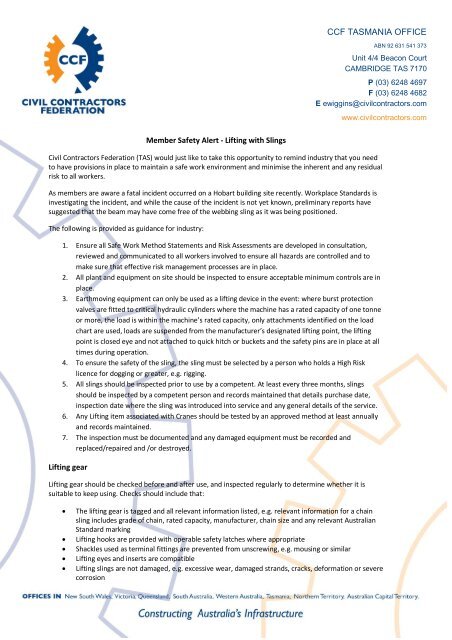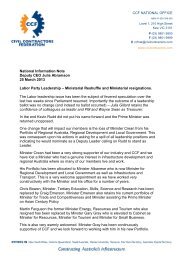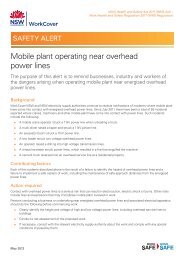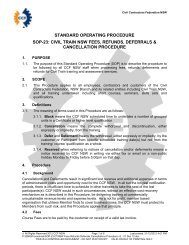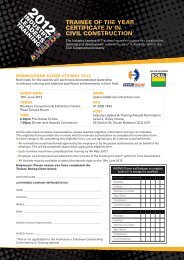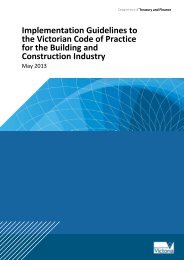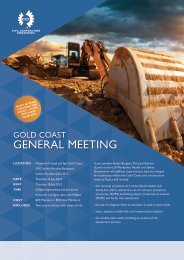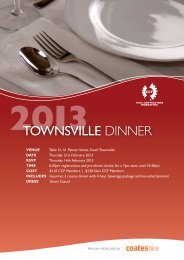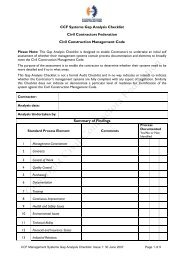Member Safety Alert - Lifting with Slings - Civil Contractors Federation
Member Safety Alert - Lifting with Slings - Civil Contractors Federation
Member Safety Alert - Lifting with Slings - Civil Contractors Federation
You also want an ePaper? Increase the reach of your titles
YUMPU automatically turns print PDFs into web optimized ePapers that Google loves.
CCF TASMANIA OFFICEABN 92 631 541 373Unit 4/4 Beacon CourtCAMBRIDGE TAS 7170P (03) 6248 4697F (03) 6248 4682E ewiggins@civilcontractors.comwww.civilcontractors.com<strong>Member</strong> <strong>Safety</strong> <strong>Alert</strong> - <strong>Lifting</strong> <strong>with</strong> <strong>Slings</strong><strong>Civil</strong> <strong>Contractors</strong> <strong>Federation</strong> (TAS) would just like to take this opportunity to remind industry that you needto have provisions in place to maintain a safe work environment and minimise the inherent and any residualrisk to all workers.As members are aware a fatal incident occurred on a Hobart building site recently. Workplace Standards isinvestigating the incident, and while the cause of the incident is not yet known, preliminary reports havesuggested that the beam may have come free of the webbing sling as it was being positioned.The following is provided as guidance for industry:1. Ensure all Safe Work Method Statements and Risk Assessments are developed in consultation,reviewed and communicated to all workers involved to ensure all hazards are controlled and tomake sure that effective risk management processes are in place.2. All plant and equipment on site should be inspected to ensure acceptable minimum controls are inplace.3. Earthmoving equipment can only be used as a lifting device in the event: where burst protectionvalves are fitted to critical hydraulic cylinders where the machine has a rated capacity of one tonneor more, the load is <strong>with</strong>in the machine’s rated capacity, only attachments identified on the loadchart are used, loads are suspended from the manufacturer’s designated lifting point, the liftingpoint is closed eye and not attached to quick hitch or buckets and the safety pins are in place at alltimes during operation.4. To ensure the safety of the sling, the sling must be selected by a person who holds a High Risklicence for dogging or greater, e.g. rigging.5. All slings should be inspected prior to use by a competent. At least every three months, slingsshould be inspected by a competent person and records maintained that details purchase date,inspection date where the sling was introduced into service and any general details of the service.6. Any <strong>Lifting</strong> item associated <strong>with</strong> Cranes should be tested by an approved method at least annuallyand records maintained.7. The inspection must be documented and any damaged equipment must be recorded andreplaced/repaired and /or destroyed.<strong>Lifting</strong> gear<strong>Lifting</strong> gear should be checked before and after use, and inspected regularly to determine whether it issuitable to keep using. Checks should include that:The lifting gear is tagged and all relevant information listed, e.g. relevant information for a chainsling includes grade of chain, rated capacity, manufacturer, chain size and any relevant AustralianStandard marking<strong>Lifting</strong> hooks are provided <strong>with</strong> operable safety latches where appropriateShackles used as terminal fittings are prevented from unscrewing, e.g. mousing or similar<strong>Lifting</strong> eyes and inserts are compatible<strong>Lifting</strong> slings are not damaged, e.g. excessive wear, damaged strands, cracks, deformation or severecorrosion
When determining the allowable load to be lifted, the mass of any attachments, for example buckets orquick-hitch, should be deducted, unless the rated capacity chart allows otherwise.To ensure the stability of the mobile plant, the rated capacity of the plant should not be greater than:75% of tipping load in the stationary mode66% of tipping load in the pick-and-carry mode50% of tipping load for articulated wheel loaders and tool carriers.Rated capacity limitersA rated capacity limiter prevents overloading of the plant by stopping all relevant functions when anoverload is detected. Rated capacity means the maximum load that may be attached and handled and maynot include the weight of the hook block, falls of rope, slings and rigging hardware. The load to be raisedshould include the weight of all lifting appliances that are not permanently attached to the plant.Load chartThe load chart for the mobile plant should identify each lift point location and the corresponding ratedcapacity for each position. The appropriate load chart should be fixed inside the operator’s cab and showthe following information:Manufacturer’s name and modelBoom and dipper arm identification and length, particularly where different boom configurationsmay be usedTrack width, where this is variableDeductions for attachments, e.g. bucket or quick-hitch devices, so that the net allowable load to belifted can be determinedOne of the following:o the rated load at the least stable positiono where variable load rating is provided for, means to clearly determine the load positionaccording to the rated capacity chart.<strong>Lifting</strong> points on earthmoving plant<strong>Lifting</strong> attachments on earthmoving plant are sometimes supplied by the plant manufacturer. If this is notthe case, the attachments should be designed by an engineer. <strong>Lifting</strong> attachments often consist of a weldedassembly that fits onto the end of the dipper arm when the bucket is removed. All lifting points onearthmoving plant should form a closed eye, to which a load rated shackle may be attached.A static strength test at 200% of the rated capacity of each lift point should be carried out. The lift pointsshould not show any permanent deformation after testing. The test may be performed <strong>with</strong> the componentdismantled from the machine—this should be done if application of the test load could result in damage tothe earthmoving plant.Hooks should not be used on the dipper arm or other attachments of earthmoving plant because the loadmay become unintentionally disengaged as the arm rotates. This can even occur when the hook is fitted<strong>with</strong> a latch, because the latch may be damaged, for example <strong>with</strong> a mobile crane, the hook hangs vertical,<strong>with</strong> an excavator, the lifting point rotates.When lifting lugs are welded to attachments or other parts of the earthmoving plant, the materialspecifications for the two different components are to be compatible for welding and the appropriatewelding procedures should be followed.The attachment of lifting lugs to buckets is strongly discouraged for the following reasons:Application of the lifted load to the outside of the bucket can load the pins and linkages in a wayother than the designer intended.It is easier for the operator to unintentionally overload the plant by not allowing for the deadweight of the bucket or because the bucket has earth stuck to the inside.
Quick-hitchesThe lifting chain or sling can be damaged when a bucket is fitted because it may pass over the frontedge of the bucket.<strong>Lifting</strong> lugs on buckets may be damaged when the bucket is used for digging activities.A quick-hitch is a latching device that enables attachments to be rapidly connected to the dipper arm orboom end of the plant. While the device saves time and effort, a number of fatalities have occurred inAustralia when excavator attachments have fallen off the quick-hitch due to loss of hydraulic pressure.Locking pins are generally used on quick-hitches to ensure the attachment is correctly engaged and remainslocked in position on the dipper arm. All quick-hitch devices should be fitted <strong>with</strong> a locking pin unless thefollowing can be ensured:A system is provided to ensure the quick-hitch device is fully engaged on the bucket or otherattachment. Note: the system should not rely on the operator carrying out a visual check on thequick-hitch attachment from the operator’s cabin.Where the quick-hitch latching device relies on stored energy, for example hydraulic fluid pressureor a spring, to be activated, the latching device should be designed so that it remains engaged inthe event of failure of the source of stored energy, for example drop in hydraulic pressure or springbreakage.Any factors that will affect the reliability of the latching device are listed in the quick-hitchmanufacturer’s instruction manual, including that any contaminants in the hydraulic fluid do notexceed limits specified by the manufacturer of the pilot-operated check valve, or other equivalentdevice. Evidence demonstrating these conditions are being met must be kept <strong>with</strong> the earthmovingplant, for example in the plant’s logbook.Burst protection and rated lifting capacitiesBurst protection should be fitted on all earthmoving plant used as a crane, where the rated capacity exceeds1 tonne. The burst protection is to be fitted to both the boom and dipper arm of the plant. Burst protectionshould comply <strong>with</strong> the performance requirements of ISO 8643: Earthmoving machinery – Hydraulicexcavator and backhoe loader boom-lowering control device – Requirements and tests.The following extra conditions should be applied:The maximum rated capacity is to be according to the manufacturer’s specifications for the plant.Single rated capacity: Unless the excavator is fully compliant <strong>with</strong> design requirements of amobile crane the lifting capacity of the plant at its maximum lifting radius is the rated capacity andis to be marked on the boom or dipper arm. The rated capacity should then be strictly observed atall times, irrespective of the radius of the load. Information should be available on site to confirmthat the rated capacity marked on the unit is the same as that specified by the manufacturer.Variable rated capacities: Where the plant has variable lifting capacities it should be fullycompliant <strong>with</strong> the design requirements for mobile cranes The manufacturer’s rated capacitychart or load chart is to be fixed to the inside of the operator’s cabin. For plant <strong>with</strong> variable ratedcapacity, the lifting capacity at minimum radius is to be used to decide whether burst protection isrequired.Burst protection device should not be provided <strong>with</strong> the ability for the operator to switch thedevice off.Where the rated capacity of the plant is 1 tonne or less and the decision is made not to fit burstprotection, the plant should not be used to lift loads near workers.Earthmoving plant owners should seek advice on fitting of burst protection from original plantmanufacturers, to help avoid fitting faulty or unsafe systems.For more information on safety requirements please contact a specialist in this area or for any otherenquiries please contact the CCF TAS Branch on (03) 62484697.


